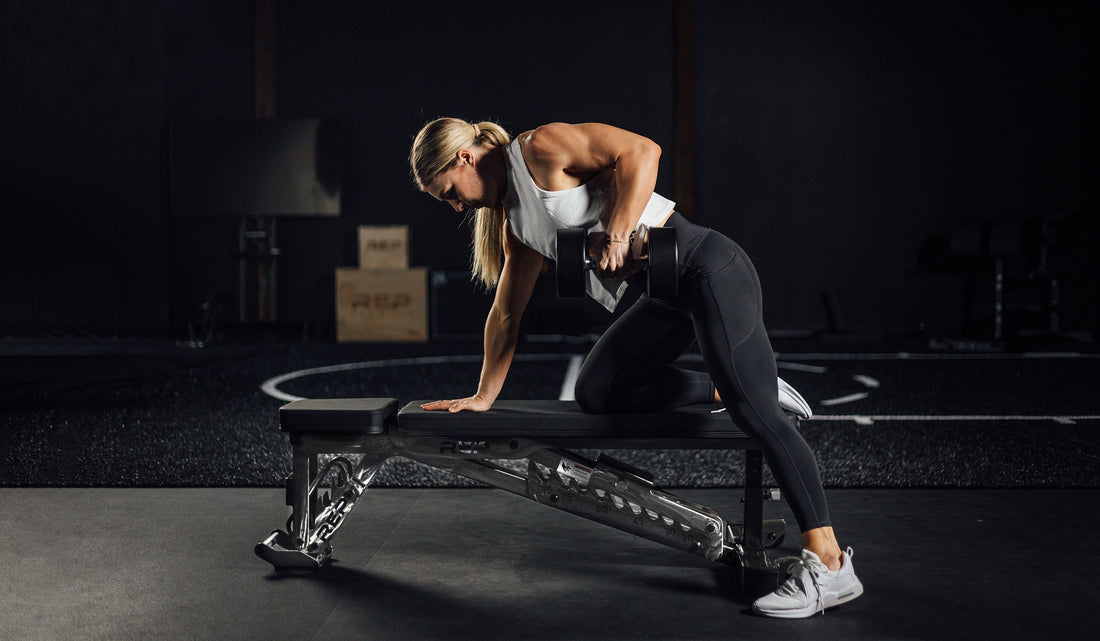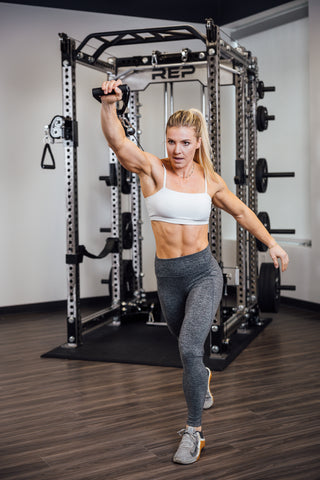
When it comes to building muscle and losing fat, the fitness world is full of conflicting advice. Some say you need to bulk and cut, while others swear by different diet and exercise strategies.
Here, we’ll break down the best methods to achieve both goals, answering common questions like “can you build muscle in a calorie deficit?” and “does fat turn into muscle?”
We want to help you understand, using reputable research, how to lower your body fat percentage, build lean mass, and develop a workout routine to support your goals.
Can You Build Muscle in a Calorie Deficit?
Let’s start with one of the biggest questions: Can you build muscle in a calorie deficit?
Conventional wisdom says you need a calorie surplus (eating more than you burn) to gain muscle. However, with the right approach, it may be possible to build lean muscle mass while in a deficit. Research shows that with sufficient protein intake and progressive resistance training, muscle gain is possible even in a calorie deficit, especially for beginners (NIH Study).
How It Works: When you're in a calorie deficit, your body uses stored fat for energy, which helps reduce overall body fat. However, if you prioritize protein intake and follow a progressive resistance training program, your body can still build muscle. This method is especially effective for beginners, as their bodies respond more rapidly to resistance exercises, enabling some level of muscle growth even when eating fewer calories (PubMed).
Practical Tips:
Eat Enough Protein: Aim for around 1.6-2.2g of protein per kilogram of body weight daily to support muscle recovery and growth (PubMed). Learn more about protein powder and how to get in your protein here.

Strength Train Regularly: Focus on compound lifts like squats, deadlifts, and bench presses to maximize muscle activation.
Prioritize Rest and Recovery: Sleep and rest days are crucial for muscle recovery, which in turn aids muscle growth (Sleep Foundation). Learn more about rest days and why they’re so important here.
Putting on Muscle in a Caloric Deficit for Experienced Lifters

As you get more experienced in the gym, this balance gets trickier, which is why you might hear bodybuilders referring to a “bulk” and “off-season,” where they intentionally gain some body fat and enter a strategic caloric surplus.
Here's why:
Diminished Returns for Advanced Lifters: As a person becomes more trained, muscle gains typically slow down. Research has shown that beginners often experience rapid muscle growth due to "newbie gains" because their bodies are highly responsive to resistance training. However, over time, it takes more effort and precise strategies to continue building muscle (Journal of Strength and Conditioning Research).
The Role of Caloric Surplus in Muscle Growth: Building muscle requires energy. Studies indicate that for trained athletes, being in a slight caloric surplus—often referred to as "bulking"—can optimize muscle protein synthesis, allowing for better muscle growth (Strength and Conditioning Journal). In contrast, attempting to build muscle while in a calorie deficit is much less effective for advanced lifters, which is why they often switch to "cutting" after a bulking phase to reduce the added body fat.
Strategic Body Fat Gain and Loss: Bodybuilders and athletes often go through "off-season" periods, where they purposefully gain some body fat to maximize muscle-building potential. Research on periodization supports this approach, suggesting that cycling between phases of bulking and cutting can optimize muscle gains while controlling body fat (Journal of Strength and Conditioning Research).
Hormonal Considerations: Being in a prolonged calorie deficit, especially at very low body fat levels, can lead to decreased levels of anabolic hormones like testosterone, which are crucial for muscle growth. The "bulking" phase can help restore these hormone levels, creating a more favorable environment for muscle gain (PubMed).
This research-based approach to alternating bulking and cutting phases helps advanced lifters continue to build muscle while maintaining manageable levels of body fat, a balance that’s much easier for beginners due to their rapid initial gains.
Does Fat Turn Into Muscle?

A common misconception is that fat turns into muscle during weight loss, but that’s not how the body works. Fat and muscle are two different types of tissue and can’t transform from one to the other. Instead, the goal is to burn fat and build muscle (National Institute of Health).
How It Works: When you exercise and eat well, your body burns fat stores for energy. At the same time, strength training creates micro-tears in muscle fibers, which then repair and grow stronger. This process helps shed body fat while adding muscle mass (ACE Fitness).
Practical Tips:

Balance Cardio and Strength Training: Cardio can help with calorie burning, but strength training is necessary for muscle development (Harvard Health).
Progressive Overload: Increase weights or reps gradually to challenge muscles and stimulate growth (National Strength and Conditioning Association).
Prioritize Consistency: Consistent effort over time is key to achieving a lean, muscular look.
Best Equipment at the Gym for Weight Loss
Using the right gym equipment can help maximize your weight loss efforts. Here are some top choices:
Treadmill: Great for high-intensity interval training (HIIT), which burns calories effectively (Journal of Obesity). Some bodybuilders also just walk on a steep incline at a brisk pace to get in low-impact cardio.
Rowing Machine: Engages the entire body, helping burn calories while strengthening muscles (PubMed).

Stair Climber: Excellent for lower body fat reduction and strengthening glutes and thighs.
Cable Machine (Functional Trainer): Helps you perform resistance exercises to build muscle, while also being versatile for cardio-based moves like high pulls and cable twists.
Dumbbells and Barbells: Essential for resistance exercises that build lean muscle mass, which can aid in fat loss over time (American Council on Exercise).
Pro Tip: Incorporate strength and cardio equipment for an effective burn session. For instance, try HIIT on the treadmill after compound lifts like deadlifts or lunges.
Best Exercise to Lose Belly Fat

Losing belly fat is one of the most common goals in fitness, and while there’s no magic exercise to spot-reduce fat, certain moves can help burn calories and that can affect the appearance of your midsection (Mayo Clinic).
HIIT Workouts: Short bursts of high-intensity exercise followed by rest periods are effective at torching calories and boosting metabolism (PubMed).
Planks and Core Work: Core-strengthening exercises like planks, Russian twists, and mountain climbers strengthen your ab muscles while enhancing stability. Here are 9 exercises for strong abs.
Compound Movements: Exercises like squats and deadlifts work multiple muscle groups, which can elevate heart rate and increase calorie burn, leading to a reduction in overall body fat (American College of Sports Medicine Health & Fitness Journal).
Cardio Intervals: Incorporating intervals of sprinting or cycling can spark fat loss in a powerful way, especially around the midsection.
Combining Diet and Exercise to Achieve Your Goals
A balanced approach of diet, exercise, and rest is essential for both building muscle and losing fat. Check out this article with tips from a dietician.

Here’s a basic breakdown:
Diet Tips:
Prioritize Protein: Protein-rich foods like lean meats, eggs, and legumes support muscle growth and can help reduce hunger (Obesity Research Journal). Need a portable, easy snack with protein? Here's what you need to know about protein bars.
Avoid Ultraprocessed Foods: These can add unnecessary calories and sugars, making fat loss harder (PubMed).
Include Healthy Fats and Complex Carbs: These macronutrients provide long-lasting energy and support body functions. Examples include whole grains, avocados, and nuts (Harvard T.H. Chan School of Public Health).
Manage Portions: Eating in a calorie deficit requires portion control. Consider using a food tracking app to stay aware of your intake (PubMed).
Exercise Tips:

Strength Train at Least 2 Times a Week: Lifting weights builds lean muscle and increases metabolic rate, which helps with burning fat (National Academy of Sports Medicine).
Incorporate Cardio Sessions: Aim for 2-3 cardio sessions weekly. HIIT is particularly effective for building muscle and supporting fat loss, while moderate-intensity cardio can torch calories but won't help you build muscle (PubMed).
Mix It Up: If you struggle with boredom, explore a variety of exercises and equipment, from dumbbells and barbells to cable machines and kettlebells, to keep workouts challenging and engaging.
Additional Tips for Beginners
Starting your fitness journey can be overwhelming, but building muscle and losing fat doesn’t have to be complicated.
Set Realistic Goals: Achieving a leaner, more muscular body takes time. Set achievable short-term goals, like increasing weight on your lifts or completing more reps (American Journal of Lifestyle Medicine). Here are 11 tips to help you actually keep your fitness resolutions.
Focus on Form: Good form is critical in exercises like squats and deadlifts to avoid injury and get the best results (Harvard Health). Check out the “Training” section in our blog for tips on how to do various exercises safely. We are constantly adding to this section, so bookmark the page and let us help you.
Stay Consistent: Consistency is key in both diet and exercise. Even small improvements add up over time.
How to Maintain Your Progress

Once you achieve your goals, maintenance becomes the next challenge. Here’s how to stay on track:
Track Progress: Regularly track body measurements, weight, and lifting performance.
Adjust Diet as Needed: Eventually, you want to shift from a calorie deficit to a maintenance phase, where you eat around your body’s daily calorie requirement to keep muscle while maintaining a lower body fat percentage (PubMed).
Keep Challenging Yourself: Avoid plateaus by increasing weights, reps, or intensity in your workouts.
Bottom Line
Building muscle while losing fat is achievable with the right strategy. By combining a balanced diet rich in protein, a mix of strength and cardio training, and consistency, you’ll be on the path to a leaner, stronger, and healthier body. Remember that progress takes time, and stay committed to your fitness journey.
Aimee Heckel, CPT, is a health and fitness journalist with over 20 years of experience. She set an all-time world-record deadlift in her division across all powerlifting federations at Mr. Olympia. In addition, she earned a national deadlift record and 18 Colorado state records. Heckel also has nine world records in grip sport, a pro card in natural figure bodybuilding, four first-place bodybuilding titles, and was named IPE Ms. Colorado Figure.

NEWSLETTER SIGNUP
Product launch information, promotions, blogs, and REP news.







